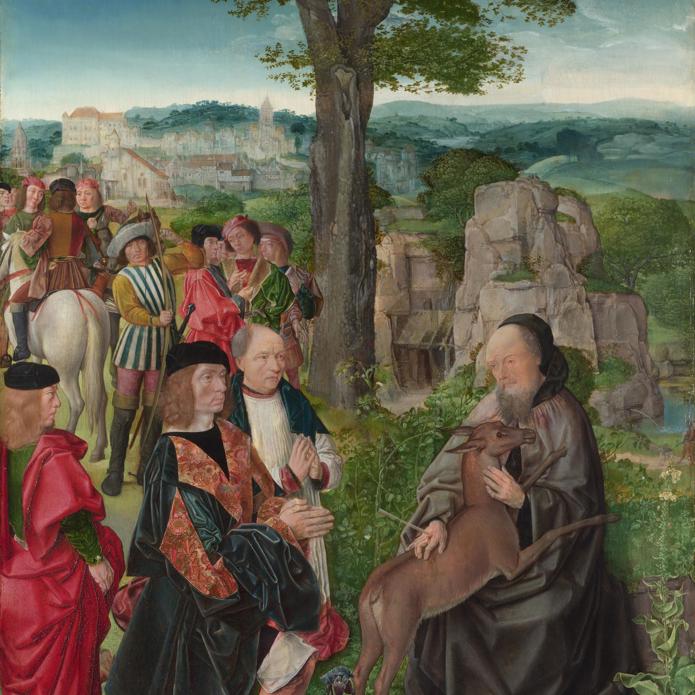Master of Saint Giles, 'The Mass of Saint Giles', about 1500
About the work
Overview
This panel is one of four surviving fragments of a large altarpiece that showed the lives of various French saints, many with royal connections. Charlemagne, Holy Roman Emperor, kneels beside an altar at which a priest is performing Mass. At the top an angel flies down from heaven with a divine proclamation.
This is one of the legends of Saint Giles, a popular French saint. Charlemagne had committed a sin so awful he was unable to confess it. While visiting him, Saint Giles celebrated mass and prayed for him. An angel appeared bearing a letter; it explained that because of Giles’s prayer, the sin was forgiven.
The church in the painting is based on a real one: the royal mausoleum of Saint Denis in Paris. This is the only surviving view of it as it was in the late Middle Ages, albeit somewhat simplified.
Key facts
Details
- Full title
- The Mass of Saint Giles
- Artist
- Master of Saint Giles
- Artist dates
- active about 1500
- Part of the series
- Two Panels from an Altarpiece
- Date made
- about 1500
- Medium and support
- oil on wood
- Dimensions
- 62.3 × 46 cm
- Acquisition credit
- Presented by the Art Fund, 1933
- Inventory number
- NG4681
- Location
- Not on display
- Collection
- Main Collection
- Previous owners
- Frame
- 20th-century Replica Frame
Provenance
Additional information
Text extracted from the ‘Provenance’ section of the catalogue entry in Lorne Campbell, ‘National Gallery Catalogues: The Sixteenth Century Netherlandish Paintings: With French Paintings before 1600’, London 2014; for further information, see the full catalogue entry.
Exhibition history
-
2010Kings, Queens, and Courtiers: Art in Early Renaissance FranceGaleries Nationales du Grand Palais6 October 2010 - 10 January 2011
-
2011Devotion by Design: Italian Altarpieces before 1500The National Gallery (London)6 July 2011 - 2 October 2011
-
2020SinThe National Gallery (London)7 October 2020 - 3 January 2021
-
2022Sin (National Touring Exhibition)Perth Museum and Art Gallery18 June 2022 - 25 September 2022York Museums Trust7 October 2022 - 22 January 2023The Arc (Hampshire Cultural Trust)24 February 2023 - 14 May 2023The Auckland Project17 June 2023 - 1 October 2023
Bibliography
-
1934National Gallery, National Gallery and Tate Gallery Directors' Reports, 1933, London 1934
-
1945Davies, Martin, National Gallery Catalogues: Early Netherlandish School, London 1945
-
1955Davies, Martin, National Gallery Catalogues: Early Netherlandish School, 2nd edn (revised), London 1955
-
1987Davies, Martin, National Gallery Catalogues: The Early Netherlandish School, 3rd edn, London 1987
-
2001
C. Baker and T. Henry, The National Gallery: Complete Illustrated Catalogue, London 2001
-
2014
L. Campbell, National Gallery Catalogues: The Sixteenth Century Netherlandish Paintings: With French Paintings before 1600, 2 vols, London 2014
Frame
This twentieth-century frame, a reproduction of a fifteenth-century Flemish-style frame, was made at the Gallery. Constructed from limewood, it is water-gilded with a craquelure finish. A reverse ogee, stepping to astragals and hollows, creates an intricate moulding on the front of the frame. The reverse of the frame has a flat and chamfered sight edge.
About this record
If you know more about this painting or have spotted an error, please contact us. Please note that exhibition histories are listed from 2009 onwards. Bibliographies may not be complete; more comprehensive information is available in the National Gallery Library.
Images
About the series: Two Panels from an Altarpiece

Overview
These two panels show episodes from the life of Saint Giles, a seventh-century hermit who was enormously popular in medieval France. They once formed part of the folding wings of a large polyptych (a multi-panelled altarpiece). Two more of its panels are in the National Gallery of Art, Washington.
When the altarpiece was open it showed scenes from lives of several saints, many with French royal connections, set in Paris churches. On the back were saints painted in tones of grey to look like statues.
We don't know exactly how the panels were originally arranged or where the altarpiece was originally located, or even who the artist was. However, he was probably working in Paris in around 1500, as in these paintings, the clothes worn by the laity (people who are not church officials) were in fashion in the first years of the sixteenth century.


